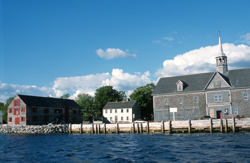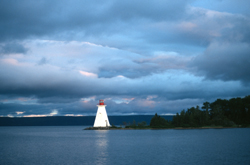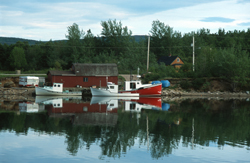On each of our Labrador voyages, we made our first entry into Canada at Shelbourne, Nova Scotia. Europeans had occupied the beautiful harbor at what is now Shelburne since the 17th century. First settlers were French Acadians who made their living on small farms and fishing the bountiful waters close inshore. But following repeated privateer raids, particularly those of 1705 and 1708, the first Acadian settlers abandoned the region.
New England based fishermen
used the fine harbor, which they called Port Roseway, for many years,
co-existing with the few settlers who again tried their luck working
the area. Then in the seemingly unending conflict for control of North
America between France and England, culminating in what Americans call
the French and Indian War, and Europeans know as the Seven Year War,
the Acadian Expulsion of 1755 brought about a clearance of settlers
that lasted decades-until yet another war resulted in thousands of settlers
in very short order.
Modern Shelbourne was founded as a refuge camp of sorts. In the spring of 1783, the Crown resettled some 5,000 Loyalists from New York and the Middle Colonies. Promises of free land, tools and provisions eased the way to what would become, eventually, their new country. They were joined by a large group of African Americans who had escaped slavery as the result of a concerted effort of the British to attempt to weaken the economy of many of the colonies. The former slaves founded nearby Birchtown, which at the time constituted the largest free Black settlement in North America.
By the fall of 1783, a second wave of settlers had arrived from the war torn colonies, and by the new year of 1784 the population had swelled to over 17,000, making Shelburne the fourth largest city in North America. This population could not be sustained, however, as the land was poor farm land, there was no developed land transport and many vital skills were absent among the refugees. By 1790 the population fell dramatically, but those who remained developed the fine harbor's potential as a fishing port and shipbuilding center.
Donald
McKay, famous later in the United States for designing and building
the fleetest of the Clipper Ships, began his shipbuilding career in
Shelburne. As his reputation and expertise grew, he relocated his yard
to Boston. But for many years numerous fine Grand Banks schooners were
built in this small town, which today retains a population of 1,875.
As an adjunct of the Grand Banks cod fishery, thousands of the requisite dories were built in the shop that is now preserved as a museum. And the cooperage continues to manufacture the casks, which for centuries held salted fish. Shelburne and the other small ports of Nova Scotia traded salt fish and lumber in the West Indies for molasses and salt. The molasses could be turned to rum, and the salt used to produce additional fish for trade. Premium grade salt cod was sold to the European markets.
Shelburne
is a Port of Entry for clearing customs and immigration into Canada,
and on each of our several voyages to Labrador we would take advantage
of its favorable location to make entry.
Generally entry into Canada, at least on our earlier voyages, required little more than a telephone call to a central processing center in Ontario. 1-800-CANPASS was what one needed to call, and then answer the relevant questions regarding the vessel and personnel. This was so even when carrying the defensive weapon of choice for the Arctic, a 12 gauge shot gun. But following Canada's regulation of firearms in 2001, a permit for the firearm made entry somewhat more complex.
The first season following the requirement of the gun registration, our phone call upon entry resulted in the central processing center making a phone call to Canada Customs in Halifax. Though it was the middle of the night, two very polite customs agents made the lengthy drive from Halifax and met us on-board. The process was handled very professionally and with great courtesy. We had the impression that the two agents fully enjoyed the chance to get out of their office and meet what they considered two adventurers.
The next season, probably because we were in Custom's database as having cleared in the year before with a shotgun, the Halifax agents simply cleared us in on the telephone. When Mark pointed out that it was necessary for us to pay the gun registration fee and have the permit stamped, the agents replied in the time honored Canadian manner when there is an absence of the proper government official required to perform a particular formal function---they told us to go to the local office of the RCMP.
Now the Mounties have for at least a hundred fifty years been Canada's bureaucratic catch-all. Dispensing justice in the Arctic, overseeing the required self-sufficiency of gold-rushing Cheechakos climbing Chilkoot Pass, or performing rescue missions, when official Canada needs a Johnny on the Spot, they rely on the Mounties. The problem is that sometimes the RCMP resents being called upon to take care of the other agencies' problems. This was so on the day that Nancy and I, along with Bill Springer, then an editor for SAIL Magazine, marched across town to the local cop shop.
Having the required paperwork in hand, as well as the required fee, we figured that this errand would present no difficulty. But the officer on duty that morning quickly identified a difficulty with this procedure; he was not in the business of taking money from the public, had no till, and no way to bureaucratically transfer the funds to another government agency. That really didn't concern Mark. All we really wanted was the stamp authorizing the permit. So when asked by the officer what he was supposed to do with the money, Mark responded, "I don't care---use it for the Policeman's Ball!" Dudley Doright the Mountie found no humor in the remark, but grumpily applied the seal nevertheless. We had become legal once again in Canada.
On
each of our several voyages, we would visit a numberl of the beautiful
small ports on Nova Scotia's Atlantic coast. Favorites were the historic
fishing port of Lunenburg and home of Canada's iconic schooner Bluenose,
Mahone Bay with it's succession of four church spires along the harbor,
Halifax where on our first voyage north we provisioned and purchased
the dozens and dozens of nautical charts that we would need to cruise
to Hudson Straits, the tiny villages of Ships Harbour and Liscomb Harbour,
and Canso, the historic fishing port and significant center of the various
English and American efforts to dislodge the French from Cape Breton.
Rather than sailing around Cape Breton, then west into Cabot Strait in order to reach the Gulf of Saint Lawrence and the Straits of Belle Isle, the short St. Peter's Canal affords access to the inland sea known as Bras d'Or Lake.
In
1630 a small, fortified trading post was established by merchants from
La Rochelle France on a small isthmus between the Atlantic and the inland
sea. Used by local Mi'kmaq peoples as a canoe portage, the isthmus was
already a well-defined area of commerce. Later the site was further
fortified in support of the French stronghold of Louisbourg. Along with
the similar fortification of St. Anne at present day Englishtown at
the northern end of Bras d'Or (Arm of Gold), these settlements served
not only as centers of commerce for French Cape Breton, but as military
outposts as well.
For many years, merchants and mariners wished for easy access to the lakes, and in 1854 a canal was blasted and dug through the isthmus. It took 15 years to cut through the solid granite hill, but by 1869 the canal opened for transit. In ensuing years, the rock walls were lined with timbers to protect vessels, locks were built at each end of the canal, and the four and a half foot lift into the lakes could be easily accomplished. By WWI, the canal was used extensively in order to avoid German U-boats by small coastal freighters and barges carrying coal from mines at Sidney and granite from the west side of the lakes. WWII saw the same important use.
In 1929 the canal was designated a National Historic Site, and today is operated by Parks Canada. Open from May to October, it is now used chiefly by pleasure boats.
 A
day's sail up the Bras d'Or Lake is the small town of Baddeck, population,
at least after the summer tourists have gone, of a little more than
900. Because of the popularity of yachting on this protected inland
sea, Baddeck has two busy boatyards, and is a popular layover point
for the few yachts sailing farther north.
A
day's sail up the Bras d'Or Lake is the small town of Baddeck, population,
at least after the summer tourists have gone, of a little more than
900. Because of the popularity of yachting on this protected inland
sea, Baddeck has two busy boatyards, and is a popular layover point
for the few yachts sailing farther north.
The location was founded in the early 17th century by Jesuit missionaries, and is not far from the early settlement at Saint Anne (1629). Following the expulsion of the French the area became the site of numerous homesteads of English and Scottish settlers. Baddeck figures prominently in Nancy's family history. Her great, great grandfather immigrated from Scotland to Cape Breton in the 1850's, eventually establishing a farm in Baddeck.
By 1841 Charles Campbell opened a store on the waterfront, catering to the numerous Scottish settlers, and small coal deposits and shipbuilding were developed between 1844 and 1881.
 In
later years the area was the summer home and workshop of Alexander Graham
Bell, and his estate is preserved today as a National Historic Site.
In
later years the area was the summer home and workshop of Alexander Graham
Bell, and his estate is preserved today as a National Historic Site.
For us Baddeck was always
an important departure point for Newfoundland, the Straits of Belle
Isle, and Labrador.